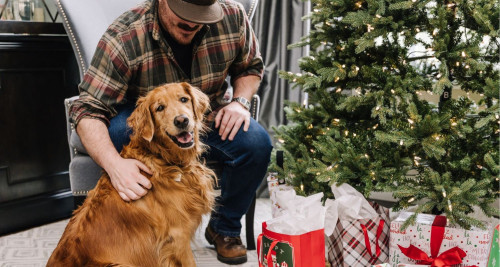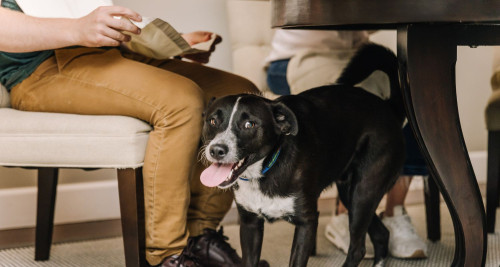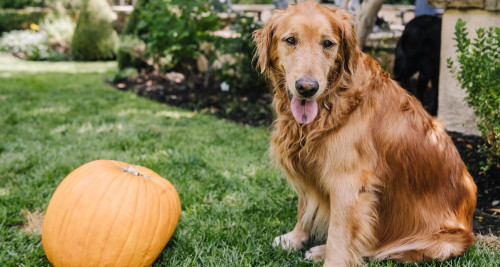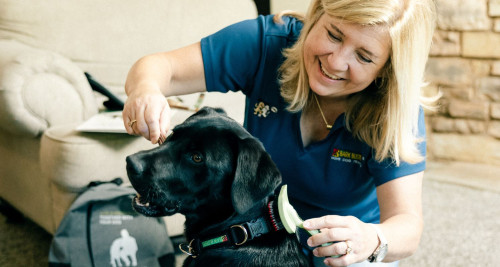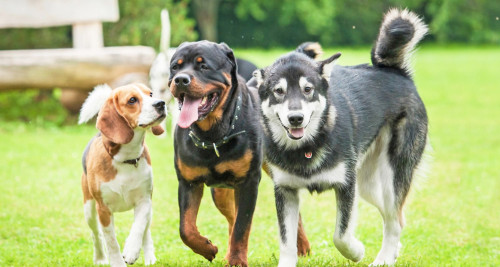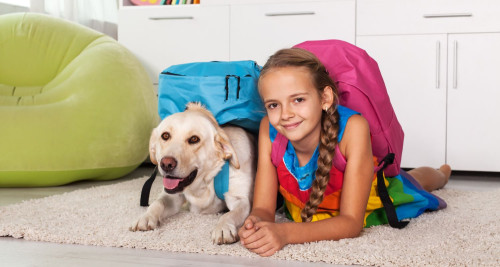Border Collie

Breed Traits and Characteristics
According to the American Kennel Club, here are some breed characteristic you can find in Border Collies.
- Height
19-22 inches (male), 18-21 inches (female)
- Weight
30-55 pounds
- Life Expectancy
12-15 years
- Coat Type/Length
Double-Wavy/Medium
-
100 Affectionate with Family
-
60 Good with Young Children
-
60 Good with Other Dogs
-
100 Trainability Level
-
100 Energy Level
-
80 Barking Level
-
60 Shedding Level
-
20 Drooling Level
History
Ever since man started raising sheep, they needed a trusty dog to help protect stock and herd from pen to pen for safe keeping. A dog’s natural herding traits was carefully bred into the Border Collie's ancestors, which originated in the border regions between Scotland and the Northern parts of England.
Farmers would show off the prowess of their best sheep dogs to other farmers while at the markets and soon developed a reputation for having the best working dog litters. The original outstanding dogs that were used to herd and guard sheep or livestock in the 1800’s were further enhanced through breeding and natural selection.
In the late 1800’s, Queen Victoria saw one of the dogs at a show and became an enthusiast of the breed.
A gentleman by the name of R.J. Lloyd Price is one of the first people to organize sheepdog trials. In 1876, he brought a hundred wild Welsh sheep to the Alexandra Palace in London for a sheep herding demonstration. The Livestock Journal described the astonishment of the spectators at the sharpness of the dogs, whose only assistance from their handlers was in the form of hand signals and whistles.
About Border Collies
An Energetic Breed
If you are thinking about a Border Collie as your next dog, you need to give some thought to the time you can devote to such an energetic breed. It would be unfair to keep this breed couped up for long hours – they are definitely not “couch potatoes.” They do not do ‘home alone’ too well and can exhibit separation anxiety. If you lock them up for hours on end, it won’t be long until you get complaints from your neighbors about endless barking.
If you have a busy lifestyle, then consider day care or dog walkers. Always do your own research into the right people to care for your precious pet. Also check that they hold adequate insurance and have experience in dealing with this breed.
Popular Working and Sporting Dog
The keenness of the Border Collie and its attractive look and appeal, is what made it a popular dog for obedience trials, dancing with dogs’ competitions, and agility competitions. Once you see a Border Collie perform, you will be impressed.
They move gracefully with determination, focused on the task ahead which is a learned behavior from their sheep dog herding ancestry. Once they lock their interest on something, nothing else takes their focus.
Border collies were bred for their stamina, always presenting their ‘A’ game. They ran all day, without exhaustion, as they accompanied the shepherds at a moment’s notice.
Border Collies are easy to train, but beware if they get bored, that’s when mischief begins. Suddenly they will be chasing squirrels, barking, chasing cats or digging. Make sure you have the time to devote to keeping their mind and body engaged. Their personality is characteristically alert, energetic, hardworking, and smart. They learn quickly — so quickly that it's sometimes difficult to keep them mentally challenged.
They are a visual breed who constantly scrutinizes your face. They are highly sensitive to your moods and subtle looks and will predict what you are about to do, even before you know what you are about to do yourself.
Border Collie Personality & Temperament
The Border Collie is renowned as a fun loving energetic breed with an outgoing personality that is constantly seeking gratification from activity. They love activities that are focused on running or chasing after things and often mix well with people and other dogs. If their energy is not pointed to something meaningful, their strong herding instinct can lead to chasing cars and small animals.
They generally have a very stable temperament, capable of fitting into most households. They can be trained to herd chickens, ducks, geese, and any livestock.
The Border Collie is a breed without too many ‘hang ups’. They generally have the perfect temperament/personality to be a safe family dog.
This can of course be dependent on their temperament, upbringing and positive exposure to things as they grow and mature.
The breed is not generally renowned for any guard dog abilities, but will naturally bark at strangers or a perceived threat. They do need to be strictly controlled or they will bark at any kind of movement if their behavior is not kept in check.
The Right Training
You need to be absolutely sure what type of training you need for your Border Collie. These are a very trainable breed but they do need understanding, patience and some thought to the type of training that suits their intelligence. They need consistency and direction and some guidance in how to hold their focus.
A highly intelligent breed such as the Border Collie needs to be doing something every single day.
Capabilities of the Breed
This is a highly capable breed that likes nothing more than to be working at any task you set for it.
- Great dog for farm work of any kind
- Excellent Frisbee catching breed
- Top dog for sheep and agility trials
- Excel at obedience competitions
- Brilliant breed for Dancing Dogs Competition
- Search and rescue
- Great family dog
- Good companion for jogging
Points of Interest
- Great all-round fun dog
- Easy to train
- Stable temperament
- Good family dog
- Need to be monitored when with children, due to their herding traits
- Energetic and athletic-great companion for the fitness loving dog owner
- Not commonly known for aggression to humans or other dogs
- Great dog for things like agility, obedience competitions, Frisbee throwing, dancing with dogs and much more.
- Love retrieving, often obsessively, especially with tennis balls
- Must be actively engaged regularly
- Highly intelligent and easy to train with basic obedience and general commands
- Barking issues are high on this breeds issues, but fixable
Bark Busters Experience with Border Collies
Border Collies are an all-round sweet dog, usually very soft in nature, but are highly driven by the chase of a ball or something that moves quickly. They are generally easy to train and love to work either in obedience trials or other types of events such as fly ball, agility or sheep herding trials.
They are fairly easy to care for, just a brush every day to make sure their coat does not get tangled, especially behind their ears.
Border Collies love to be around the family, but still happy to be on their own, but without proper training they can be a nuisance with their barking and herding tendencies. f you are consistent you will have no problem training a Border Collie, they love to learn new things.
Case Study with Donna Ryan, Bark Busters International Head Trainer
Millie – a rescue puppy -- was 6 months of age when Bark Busters was called in to address her unpredictable aggression towards strangers.
Millie would growl and snap if strangers approached or tried to touch her. This is quite common behavior in temperaments such as the one that Millie has, which we diagnosed as ‘fearful’.
Many puppies are born with a fearful or shy temperament that makes them predisposed to overacting when strangers approach or try to touch them.
We started out explaining dog psychology to her doggie parents and the fact that all dogs need strong leaders and especially dogs with Millie’s temperament.
When they don‘t get the much-needed leadership and security they crave, they become concerned for their own well-being and they then take matters into their own control and start acting out.
This aggression can commence at about 6-12 months of age and when it happens it catches everyone, who knows and loves them, by surprise.
It’s a self-protection response that is simply indicating to the approaching stranger that they should STOP their approach or the consequences could be dire.
The reason that this ‘aggression to strangers’ generally starts somewhere beyond 6 months of age, is due to the fact that young pups won’t deal with things, they usually just practice avoidance, until they feel capable of seriously repelling an approach.
We started her owners off with some basic commands for them to gain control of Millie’s aggression. We explained that she needs to always know that she can default to them when things don’t go her way or when she feels she needs protection. Where the owner is concerned, it’s a ‘we have this’ approach, so she learns that her humans will take care of things that scare her.
We also had them change the way people interacted with her. They have to be pro-active, raise their hand in a stop signal, and hand the approaching person a packet of treats. Visitors should then throw her a treat versus trying to pet her or stare directly into her eyes.
This worked amazingly. In no time Millie felt less concerned or worried about approaching strangers, knowing the humans had control and she was in safe hands.
She actually began seeking people out more as they approached and waited for the treat she knew was coming.
Border Collie Health
Everyday Illnesses and Injuries
At any stage of life, here are some of the most common injuries and illnesses you should be aware of when bringing home a Border Collie:
- Arthritis
- Epilepsy
- Eye issues
- Hip and elbow dysplasia
- Joint disease
Your Border Collie’s health concerns will change over the course of their life. A puppy might be more prone to eat something they shouldn’t, a 2-year-old Border Collie may be more likely to show signs of separation anxiety, and a senior Border Collie is far more likely to develop arthritis as they age. Border Collie’s also have personality and physical traits that may make them more prone to certain conditions or situations—because they are an incredibly intelligent breed, a Border Collie without enough mental stimulation may become frustrated more likely to get into trouble.
Genetic Health Concerns
The Border Collie is generally a healthy breed, but this doesn’t excuse them from genetic conditions like hip and elbow dysplasia. Most reputable breeders now have their breeding stock checked and scored for these hereditary ailments by a vet. You can request proof that the puppy you are purchasing comes from parents that have been checked for these issues.
Because many other health issues are also hereditary, you should do some research on the ancestry of your puppy and any health issues of that particular breed.
Many rescue organizations also check for common-ailments before making them available for adoption.
Common Behavioral Issues with Border Collies
Barking
The Border Collie is a barking breed. They are easily visually stimulated which is often why they bark so much. They will bark at anything that moves quickly, such as bikes, skate boards and the like.
Barking in the car, barking at people on bikes, and barking at lawnmowers are high on the list of behavioral issues that Bark Busters training addresses.
Dogs do not have great discerning abilities. They see something whizzing past and it concerns them. They don’t recognize it as a human on a skateboard or a human on a bike. They bark just to send it on its way. The fact that it was already going that way is lost on the dog and it mistakenly believes that their barking is what dispatched it.
With the Border Collie breed, you also have the strong herding instinct and that just adds to the problem.
As mentioned earlier, the Border Collie is easily stimulated visually. It’s that look that they use to intimidate the sheep that is at play here. Dogs can become over-stimulated in cars as images do flashing by.
Connect with Us!
Need help training your Border Collie? Call 1-877-500-BARK (2275)or enter your zip code.
Tips for Every Dog Owner
Hear from Bark Busters Clients Who Have a Border Collie
Ready for a Better-Behaved Border Collie? Fill Out Our Form and Explore the Benefits of Professional Training!
Confirm your zip code and complete this quick form, and we’ll reach out within 24 hours by email or phone to discuss your dog’s training needs. Skip the hassle of group classes with personalized, in-home training near you.
- 99.7% 4 or 5 stars 99.7% rate their experience with Bark Busters as 4 or 5 out of 5 stars.
- 99.6% Would Recommend 99.6% would recommend Bark Busters to their friends and neighbors.
- 99.5% Dog Responded 99.5% think their dog responded well to the training.
Need Dog Training Assistance with your Border Collie? Find Your Local Trainer Now!
CALL TODAY 1-877-500-BARK (2275)
